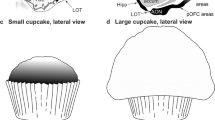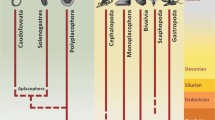Summary
The pineal of the facultative, cave-dwelling fish,Chologaster agassizi, was examined electron microscopically. Two cell types, photoreceptor and supportive cells, were identified in the pineal epithelium. The photoreceptor cells had well developed outer segments and contained Golgi bodies which were surrounded by both clear and dense-cored vesicles. Vesicle-crowned rods were frequently seen in various regions of the cell. The supportive cells also contained Golgi bodies from which both clear and dense-cored vesicles appeared to originate. In addition, these cells were characterized by peculiar arrangements of the smooth endoplasmic reticulum and the presence of pigment granules. Large quantities of glycogen were observed in both cell types. Small, unmyelinated nerve fibers were seen coursing throughout the pineal epithelium. Terminals filled with pleomorphic, clear vesicles and dense-cored vesicles were present in the vicinity of these nerve fibers. Similar vesicle-filled terminals were observed in close association with the supportive cells.
The results of this study indicate that the pineal in this light-deprived species is a metabolically active organ capable of photoreception. Specializations of the organelles in the pineal cells were similar to those observed in other vertebrates living in environments of low light levels.
Similar content being viewed by others
References
Bergmann, G. Elektronenmikroskopische Untersuchungen am Pinealorgan von Pterophyllum scalare Cuv. et Val. (Cichlidae, Teleostei). Z. Zellforsch.119, 257–288 (1971).
Clabough, J. W. Ultrastructural features of the pineal gland in normal and light deprived golden hamsters. Z. Zellforsch.114, 151–164 (1971).
Collin, J. P. Contribution a l'étude de l'organe pinéal. De l'épiphyse sensorielle a la glande pinéale: modalités de transformation et implications fonctionelles. Ann. Stat. Biol. de Besse-en Chandesse, Suppi.1, 1–359 (1969).
Collin, J. P.: Differentation and regression of the cells of the sensory line in the epiphysis cerebri. In: The Pineal Gland, Symposium of the Ciba Foundation, London 1970 (Wolstenholme, G. E. W., Knight, J., eds.), pp. 79–125. Churchill Livingstone. 1971.
Delahunty, G., Schreck, C. B., de Vlaming, V. L. Effect of pinealectomy, reproductive state, feeding regime and photoperiod on plasma cortisol in goldfish (Abst). Am. Zool.17, 873 (1977).
de Vlaming, V. L. Effects of pinealectomy on gonadal activity in the cyprinid teleost, Notemigonus crysoleucas. Gen. Comp. Endocrinol.26, 36–49 (1975 a).
de Vlaming, V. L. Effects of photoperiod-temperature regimes and pinealectomy on body fat reserves in the golden shiner, Notemigonus crysoleucas. Fish. Bull.73, 766–776 (1975 b).
de Vlaming, V. L., Sage, M., Charlton, C. B. The effects of melatonin treatment on gonosomatic index in the teleost, Fundulus similis, and the tree frog, Hyla, cinerea. Gen. Comp. Endocrinol.22, 433–438 (1974).
Dodt, E. Photosensitivity of the pineal organ in the teleost Salmo irideus (Gibbons). Experientia (Basel)19, 642–644 (1963).
Dodt, E. The parietal eye (pineal and parietal organs) of lower vertebrates. In: Handbook of Sensory Physiology, Vol. VII/3B (Jung, R., ed.), pp. 113–140. Berlin-Heidelberg-New York: Springer. 1973.
Fenwick, J. C. Demonstration and effect of melatonin in fish. Gen. Comp. Endocrinol.14, 86–97 (1970 a).
Fenwick, J. C. The pineal organ: photoperiod and reproductive cycles in the goldfish. J. Endocrinol.46, 101–111 (1970 b).
Hafeez, M. A., Merhige, M. E. Light and electron microscopic study on the pineal complex of the Coelocanth, Latimeria chalumnae Smith. Cell Tiss. Res.178, 249–265 (1977).
Hafeez, M. A., Quay, W. B. Histochemical and experimental studies of 5-hydroxytryptamine in pineal organs of teleosts (Salmo gairdneri and Atherinopsis calif orniensis). Gen. Comp. Endocrinol.13, 211–217 (1969).
Hafeez, M. A., Quay, W. B. Pineal acetylserotonin methyltransf erase activity in the teleost fishes, Hesperoleucus symmetrical and Salmo gairdneri, with evidence for lack of effect of constant light and darkness. Comp. gen. Pharmacol.1, 257–262 (1970).
Hafeez, M. A., Zerihun, L. Autoradiographic localization of3H-5-HTP and3H-5-HT in the pineal organ and circumventricular areas of the rainbow trout, Salmo gairdneri Richardson. Cell Tiss. Res.170, 61–76 (1976).
Hanyu, I., Niwa, H. Pineal photosensitivity in three teleosts, Salmo irideus, Plecoglossus altivelis and Mugil cephalus. Rev. Canad. Biol.29, 133 to 140 (1970).
Hanyu, I., Niwa, H., Tamura, T. A slow potential from the epiphysis cerebri of fishes. Vision Res.9, 621–623 (1969).
Herwig, H. J. Comparative ultrastructural investigations of the pineal organ of the blind cave fish,Anopticbthys jordani, and its ancestor, the eyed river fish,Astyanax mexicanus. Cell Tiss. Res.167, 297–324 (1976).
Hoar, W. S. Phototactic and pigmentary responses of sockeye salmon smolts following injury to the pineal organ. J. Fish. Res. Bd. Canada12, 178–185 (1955).
Kappers, J. Ariëns: The pineal organ: an introduction. In: The Pineal Gland, Symposium of the Ciba Foundation, London 1970 (Wolsten-holme, G. E. W., Knight, J., eds.), pp. 3–25. Churchill Livingstone. 1971.
Kappers, J. Ariëns The mammalian pineal gland, a survey. Acta Neurochir.34, 109–149 (1976).
Karasek, M. Quantitative changes in number of “synaptic” ribbons in rat pinealocytes after orchidectomy and in organ culture. J. Neural Trans.38, 149–157 (1976).
Korf, H. W. Histological, histochemical and electron microscopical studies on the nervous apparatus of the pineal organ in the Tiger Salamander,Ambystoma tigrinum. Cell Tiss. Res.174, 475–497 (1976).
Kurumado, K., Mori, W. A morphological study of the circadian cycle of the pineal gland of the rat. Cell Tiss. Res.182, 565–568 (1977).
Marshall, N. B., Thines, G. L. Studies of the brain, sense organs and light sensitivity of a blind cave fish (Typhlogarra widdowsoni) from Iraq. Proc. Zool. Soc. (London)131, 441–456 (1958).
Matsushima, S., Reiter, R. J. Comparative ultrastructural studies of the pineal gland of rodents. In: Electron Microscopic Concepts of Secretion: Ultrastructure of Endocrine and Reproductive Organs (Hess, M., ed.). New York: John Wiley & Sons. 1975 a.
Matsushima, S., Reiter, R. J. Ultrastructural observations of pineal gland capillaries in four rodent species. Am. J. Anat.143, 265–282 (1975 b).
Matsushima, S., Reiter, R. J. Fine structural features of adrenergic nerve fibers and endings in the pineal gland of the rat, ground squirrel and chinchilla. Am. J. Anat.148, 463–478 (1977).
McNulty, J. A. A comparative study of the pineal complex in the deep-sea fishesBathylagus wesethi andNezumia liolepis. Cell Tiss. Res.172, 205–225 (1976).
McNulty, J. A.: A light and electron microscopic study of the pineal in the blind goby, Typhlogobius californiensis (Pisces: Gobiidae). J. Comp. Neurol. (in press).
McNulty, J. A., Nafpaktitis, B. G. The structure and development of the pineal complex in the lanternfishTriphoturus mexicanus (family Myctophidae). J. Morph.150, 579–605 (1976).
McNulty, J. A., Nafpaktitis, B. G. Morphology of the pineal complex in seven species of lanternfishes (Pisces: Myctophidae). Amer. J. Anat.150, 509–530 (1977).
Morita, Y. Entladungsmuster pinealer Neurone der Regenbogenforelle (Salmo irideus) bei Belichtung des Zwischenhirns. Pflügers Arch. Ges. Physiol.289, 155–167 (1966).
Morita, Y., Bergmann, G. Physiologische Untersuchungen und weitere Bemerkungen zur Struktur des lichtempfindlichen Pinealorgans vonPtero-phyllum scalare Cuv. et Val. (Cichlidae, Teleostei). Z. Zellforsch.119, 289–294 (1971).
Oguri, M., Omura, Y. Ultrastructural and functional significance of the pineal organ of teleost. In: Responses of Fish to Environmental Changes (Chavin, W., ed.), pp. 412–434. Springfield: Ch. C Thomas. 1973.
Oksche, A.: Sensory and glandular elements of the pineal organ. In: The Pineal Gland, Symposium of the Ciba Foundation, London 1970 (Wolstenholme, G. E. W., Knight, J., eds.), pp. 127–146. Churchill Livingstone. 1971.
Oksche, A., Kirschstein, H. Die Ultrastruktur der Sinneszellen im Pineal-organ von Phoxinus laevis L. Z. Zellforsch.78, 151–166 (1967).
Oksche, A., Kirschstein, H. Weitere elektronenmikroskopische Untersuchungen am Pinealorgan von Phoxinus laevis (Teleostei, Cyprinidae). Z. Zellforsch.112, 572–588 (1971).
Olcese, J., de Vlaming, V. L. Possible pineal organ involvement in the control of hypothalamic monoamine oxidase activity in the goldfish (Abst). Am. Zool.17, 875 (1977).
Omura, Y. Influence of light and darkness on the ultrastructure of the pineal organ in the blind cavefish,Astyanax mexicanus. Cell Tiss. Res.160, 99–112 (1975).
Owman, C. H., Rüdeberg, C. Light, fluorescence, and electron microscopic studies on the pineal organ of the pike,Esox lucius L., with special regard to 5-hydroxytryptamine. Z. Zellforsch.107, 522–550 (1970).
Pang, P. K. T. Light sensitivity of the pineal gland in blindedFundulus hcterditus (Abst). Am. Zool.5, 682 (1965).
Pevet, P. The pineal gland of the mole (Talpa europaea L.). I. The fine structure of the pinealocytes. Cell Tiss. Res.153, 277–292 (1974).
Pevet, P.: Correlations between pineal gland and sexual cycle. An electron microscopical and histochemical investigation on the pineal gland of the hedgehog, mole, mole-rat and white rat. Thesis, Amsterdam 1976.
Pevet, P. On the presence of different populations of pinealocytes in the mammalian pineal gland. J. Neural Trans.40, 289–304 (1977).
Pevet, P., Smith, A. R. The pineal gland of the mole (Talpa europaea L.). II Ultrastructural variations observed in the pinealocytes during different parts of the sexual cycle. J. Neural Trans.36, 227–248 (1975).
Pevet, P., Kappers, J. Ariëns, Nevo, E. The pineal gland of the mole-rat (Spalax ehrenbergi, Nehring). I. The fine structure of pinealocytes. Cell Tiss. Res.174, 1–24 (1976).
Pevet, P., Kappers, J. Ariëns, Voute, A. M. The pineal gland of nocturnal mammals. I. The pinealocytes of the bat (Nyctalus noctula, Schreber). J. Neural Trans.40, 47–68 (1977 a).
Pevet, P., Kappers, J. Ariëns, Voute, A. M. Morphologic evidence for differentiation of pinealocytes from photoreceptor cells in the adult noctule bat (Nyctalus noctula, Schreber). Cell Tiss. Res.182, 99–109 (1977 b).
Poulson, T. L. Cave adaptation in amblyopsid fishes. Am. Midland Nat.70, 257–290 (1963).
Reiter, R. J. The Pineal-1977, 184 pp. Montreal: Eden Press. 1977.
Relkin, R. The Pineal, 187 pp. Montreal: Eden Press. 1976.
Romijn, H. J., Mud, M. T., Walters, P. S. Electron microscopic evidence of glycogen storage in dark pinealocytes of rabbit pineal gland. J. Neural Trans.40, 69–80 (1977).
Rüdeberg, C. Electron microscopic observations on the pineal organ of the teleostsMugil auratus (Risso) andUranoscopus scaber (Linne). Pubbl. Staz. Zool. Napoli35, 47–60 (1966).
Rüdeberg, C. Structure of the pineal organ of the sardine,Sardina pilchar-dus sardina (Rissor), and some further remarks on the pineal organ of Mugil spp. Z. Zellforsch.84, 219–237 (1968).
Rüdeberg, C. Light and electron microscopic studies on the pineal organ of the dogfish, Scyliorhinus canicula L. Z. Zellforsch.96, 548–581 (1969).
Rüdeberg, C. Structure of the pineal organs ofAnguilla. anguilla L. andLebistes reticulatus Peters. Z. Zellforsch.122, 227–243 (1971).
Smith, J. R., Weber, L. J. The regulation of day-night changes in hydroxy-indole-O-methyltransferase activity in the pineal gland of steelhead trout (Salmo gairdneri). Can. J. Zool.54, 1530–1534 (1976).
Tabata, M., Tamura, T., Niwa, H. Origin of the slow potential in the pineal organ of the rainbow trout. Vision Res.15, 737–740 (1975).
Takahashi, H. Light and electron microscopic studies on the pineal organ of the goldfish,Carassius auratus L. Bull. Fac. Fish. Hokkaido Univ.21, 79–89 (1969).
Takahashi, H., Kasuga, S. Fine structure of the pineal organ of the Medaka,Oryzias latipes. Bull. Fac. Fish. Hokkaido Univ.22, 1–10 (1971).
Urasaki, H. Role of the pineal gland in gonadal development in the fish, Oryzias latipes. Ann. zool. jap.45, 152–158 (1972).
Urasaki, H. Effect of pinealectomy and photoperiod on oviposition and gonadal development in the fish,Oryzias latipes. J. exp. Zool.185, 241–246 (1973).
Vollrath, L. Synaptic ribbons of a mammalian pineal gland-circadian changes. Z. Zellforsch.145, 171–183 (1973).
Wolfe, D. E. The epiphyseal cell: An electron-microscopic study of its intercellular relationships and intracellular morphology in the pineal body of the albino rat. Prog. Brain Res.10, 332–386 (1965).
Author information
Authors and Affiliations
Rights and permissions
About this article
Cite this article
McNulty, J.A. The pineal of the troglophilic fish,Chologaster agassizi: An ultrastructural study. J. Neural Transmission 43, 47–71 (1978). https://doi.org/10.1007/BF02029018
Received:
Issue Date:
DOI: https://doi.org/10.1007/BF02029018




